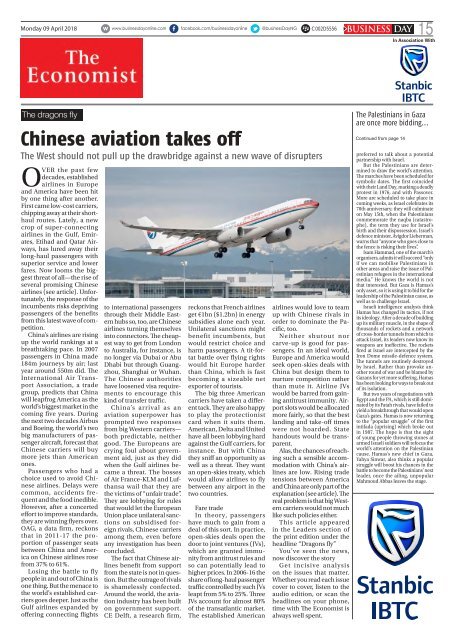BusinessDay 09 Apr 2018
Create successful ePaper yourself
Turn your PDF publications into a flip-book with our unique Google optimized e-Paper software.
Monday <strong>09</strong> <strong>Apr</strong>il <strong>2018</strong><br />
C002D5556<br />
BUSINESS DAY<br />
15<br />
In Association With<br />
The dragons fly<br />
Chinese aviation takes off<br />
The West should not pull up the drawbridge against a new wave of disrupters<br />
OVER the past few<br />
decades, established<br />
airlines in Europe<br />
and America have been hit<br />
by one thing after another.<br />
First came low-cost carriers,<br />
chipping away at their shorthaul<br />
routes. Lately, a new<br />
crop of super-connecting<br />
airlines in the Gulf, Emirates,<br />
Etihad and Qatar Airways,<br />
has lured away their<br />
long-haul passengers with<br />
superior service and lower<br />
fares. Now looms the biggest<br />
threat of all—the rise of<br />
several promising Chinese<br />
airlines (see article). Unfortunately,<br />
the response of the<br />
incumbents risks depriving<br />
passengers of the benefits<br />
from this latest wave of competition.<br />
China’s airlines are rising<br />
up the world rankings at a<br />
breathtaking pace. In 2007<br />
passengers in China made<br />
184m journeys by air; last<br />
year around 550m did. The<br />
International Air Transport<br />
Association, a trade<br />
group, predicts that China<br />
will leapfrog America as the<br />
world’s biggest market in the<br />
coming five years. During<br />
the next two decades Airbus<br />
and Boeing, the world’s two<br />
big manufacturers of passenger<br />
aircraft, forecast that<br />
Chinese carriers will buy<br />
more jets than American<br />
ones.<br />
Passengers who had a<br />
choice used to avoid Chinese<br />
airlines. Delays were<br />
common, accidents frequent<br />
and the food inedible.<br />
However, after a concerted<br />
effort to improve standards,<br />
they are winning flyers over.<br />
OAG, a data firm, reckons<br />
that in 2011-17 the proportion<br />
of passenger seats<br />
between China and America<br />
on Chinese airlines rose<br />
from 37% to 61%.<br />
Losing the battle to fly<br />
people in and out of China is<br />
one thing. But the menace to<br />
the world’s established carriers<br />
goes deeper. Just as the<br />
Gulf airlines expanded by<br />
offering connecting flights<br />
to international passengers<br />
through their Middle Eastern<br />
hubs so, too, are Chinese<br />
airlines turning themselves<br />
into connectors. The cheapest<br />
way to get from London<br />
to Australia, for instance, is<br />
no longer via Dubai or Abu<br />
Dhabi but through Guangzhou,<br />
Shanghai or Wuhan.<br />
The Chinese authorities<br />
have loosened visa requirements<br />
to encourage this<br />
kind of transfer traffic.<br />
China’s arrival as an<br />
aviation superpower has<br />
prompted two responses<br />
from big Western carriers—<br />
both predictable, neither<br />
good. The Europeans are<br />
crying foul about government<br />
aid, just as they did<br />
when the Gulf airlines became<br />
a threat. The bosses<br />
of Air France-KLM and Lufthansa<br />
wail that they are<br />
the victims of “unfair trade”.<br />
They are lobbying for rules<br />
that would let the European<br />
Union place unilateral sanctions<br />
on subsidised foreign<br />
rivals, Chinese carriers<br />
among them, even before<br />
any investigation has been<br />
concluded.<br />
The fact that Chinese airlines<br />
benefit from support<br />
from the state is not in question.<br />
But the outrage of rivals<br />
is shamelessly confected.<br />
Around the world, the aviation<br />
industry has been built<br />
on government support.<br />
CE Delft, a research firm,<br />
reckons that French airlines<br />
get €1bn ($1.2bn) in energy<br />
subsidies alone each year.<br />
Unilateral sanctions might<br />
benefit incumbents, but<br />
would restrict choice and<br />
harm passengers. A tit-fortat<br />
battle over flying rights<br />
would hit Europe harder<br />
than China, which is fast<br />
becoming a sizeable net<br />
exporter of tourists.<br />
The big three American<br />
carriers have taken a different<br />
tack. They are also happy<br />
to play the protectionist<br />
card when it suits them.<br />
American, Delta and United<br />
have all been lobbying hard<br />
against the Gulf carriers, for<br />
instance. But with China<br />
they sniff an opportunity as<br />
well as a threat. They want<br />
an open-skies treaty, which<br />
would allow airlines to fly<br />
between any airport in the<br />
two countries.<br />
Fare trade<br />
In theory, passengers<br />
have much to gain from a<br />
deal of this sort. In practice,<br />
open-skies deals open the<br />
door to joint ventures (JVs),<br />
which are granted immunity<br />
from antitrust rules and<br />
so can potentially lead to<br />
higher prices. In 2006-16 the<br />
share of long-haul passenger<br />
traffic controlled by such JVs<br />
leapt from 5% to 25%. Three<br />
JVs account for almost 80%<br />
of the transatlantic market.<br />
The established American<br />
airlines would love to team<br />
up with Chinese rivals in<br />
order to dominate the Pacific,<br />
too.<br />
Neither shutout nor<br />
carve-up is good for passengers.<br />
In an ideal world,<br />
Europe and America would<br />
seek open-skies deals with<br />
China but design them to<br />
nurture competition rather<br />
than mute it. Airline JVs<br />
would be barred from gaining<br />
antitrust immunity. Airport<br />
slots would be allocated<br />
more fairly, so that the best<br />
landing and take-off times<br />
were not hoarded. State<br />
handouts would be transparent.<br />
Alas, the chances of reaching<br />
such a sensible accommodation<br />
with China’s airlines<br />
are low. Rising trade<br />
tensions between America<br />
and China are only part of the<br />
explanation (see article). The<br />
real problem is that big Western<br />
carriers would not much<br />
like such policies either.<br />
This article appeared<br />
in the Leaders section of<br />
the print edition under the<br />
headline “Dragons fly”<br />
You’ve seen the news,<br />
now discover the story<br />
Get incisive analysis<br />
on the issues that matter.<br />
Whether you read each issue<br />
cover to cover, listen to the<br />
audio edition, or scan the<br />
headlines on your phone,<br />
time with The Economist is<br />
always well spent.<br />
The Palestinians in Gaza<br />
are once more bidding...<br />
Continued from page 14<br />
preferred to talk about a potential<br />
partnership with Israel.<br />
But the Palestinians are determined<br />
to draw the world’s attention.<br />
The marches have been scheduled for<br />
symbolic dates. The first coincided<br />
with their Land Day, marking a deadly<br />
protest in 1976, and with Passover.<br />
More are scheduled to take place in<br />
coming weeks, as Israel celebrates its<br />
70th anniversary; they will culminate<br />
on May 15th, when the Palestinians<br />
commemorate the naqba (catastrophe),<br />
the term they use for Israel’s<br />
birth and their dispossession. Israel’s<br />
defence minister, Avigdor Lieberman,<br />
warns that “anyone who goes close to<br />
the fence is risking their lives”.<br />
Isam Hammad, one of the march’s<br />
organisers, admits it will succeed “only<br />
if we can mobilise Palestinians in<br />
other areas and raise the issue of Palestinian<br />
refugees in the international<br />
media.” He knows the world is not<br />
that interested. But Gaza is Hamas’s<br />
only asset, so it is using it to bid for the<br />
leadership of the Palestinian cause, as<br />
well as to challenge Israel.<br />
Israeli intelligence analysts think<br />
Hamas has changed its tactics, if not<br />
its ideology. After a decade of building<br />
up its military muscle, in the shape of<br />
thousands of rockets and a network<br />
of cross-border tunnels from which to<br />
attack Israel, its leaders now know its<br />
weapons are ineffective. The rockets<br />
fired at Israel are intercepted by the<br />
Iron Dome missile-defence system.<br />
The tunnels are routinely destroyed<br />
by Israel. Rather than provoke another<br />
round of war and be blamed by<br />
Gazans for yet more suffering, Hamas<br />
has been looking for ways to break out<br />
of its isolation.<br />
But two years of negotiations with<br />
Egypt and the PA, which is still dominated<br />
by its Fatah rivals, have failed to<br />
yield a breakthrough that would open<br />
Gaza’s gates. Hamas is now returning<br />
to the “popular struggle” of the first<br />
intifada (uprising) which broke out<br />
in 1987. The hope is that the sight<br />
of young people throwing stones at<br />
armed Israeli soldiers will refocus the<br />
world’s attention on the Palestinian<br />
cause. Hamas’s new chief in Gaza,<br />
Yahya Sinwar, also thinks a popular<br />
struggle will boost his chances in the<br />
battle to become the Palestinians’ next<br />
leader, once the ailing, unpopular<br />
Mahmoud Abbas leaves the stage.


















